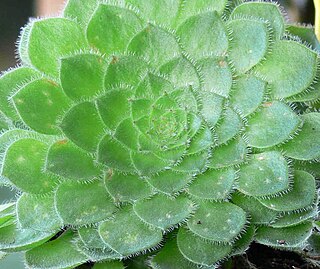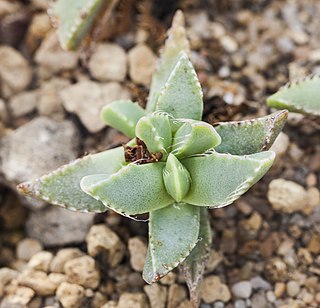
Echeveria is a large genus of flowering plants in the family Crassulaceae, native to semi-desert areas of Central America, Mexico and northwestern South America.

Dudleya, commonly known as liveforevers is a genus of rosette-forming succulent plants in the stonecrop family, Crassulaceae, consisting of about 68 taxa in southwestern North America and Guadalupe Island. The species come in many forms, some large and evergreen, others geophytic and deciduous. Yet, despite their dramatic variations in appearance, most species readily hybridize. The flowers of Dudleya have parts numbered in fives, with the petals arranged in tubular, star-shaped, and bell-shaped forms and, when fruiting, are filled with tiny, ovoid-crescent-shaped seeds.

Dudleya farinosa is a species of succulent plant in the family Crassulaceae known by several common names, including bluff lettuce, powdery liveforever, and powdery dudleya. A coastal plant of northern California and southern Oregon, it is typically found on ocean bluffs just directly above the reach of the waves, and sometimes inland. Its appearance is characterized by lotus-like rosettes of beveled leaves, and in summer the plant erects a tall pink to red peduncle densely covered in bracts, topped with branches of pale yellow flowers. The green or white rosettes of this plant can be seen covering stretches of rocky coast and nearby islets.

The Desert Garden Conservatory is a large botanical greenhouse and part of the Huntington Library, Art Collections and Botanical Gardens, in San Marino, California. It was constructed in 1985. The Desert Garden Conservatory is adjacent to the 10-acre (40,000 m2) Huntington Desert Garden itself. The garden houses one of the most important collections of cacti and other succulent plants in the world, including a large number of rare and endangered species. The 3,000-square-foot (280 m2) Desert Garden Conservatory serves The Huntington and public communities as a conservation facility, research resource and genetic diversity preserve. John N. Trager is the Desert Collection curator.

Aeonium tabuliforme, the flat-topped aeonium or saucer plant, is a species of succulent plant in the family Crassulaceae, native and endemic to Tenerife in the Canary Islands. It is low-growing, typically reaching about 5 cm high but up to 45 cm in diameter. It grows on moist, north-facing cliffs and ledges at low altitude. A mass of fleshy, hairy, bright green leaves in flat rosettes is produced on short unbranched stems, often on vertical surfaces. This species is short-lived and dies after flowering. Plants often take 3–4 years to flower, at which point they produce a tall (40–60 cm) raceme of yellow flowers.

Echeveria elegans, the Mexican snow ball, God's Throne, Mexican gem or white Mexican rose is a species of flowering plant in the family Crassulaceae, native to semi-desert habitats in Mexico.

Echeveria agavoides, or 'lipstick' echeveria, is a species of succulent flowering plant of the stonecrop (sedum) family Crassulaceae, native to the rocky canyons and arid hillsides of Central Mexico. It is primarily known from the states of Aguascalientes, Durango, Guanajuato, Hidalgo, Jalisco, Querétaro, San Luis Potosí and Zacatecas, though it has been sighted as far north as Coahuila and as far south as Oaxaca.

Echeveria runyonii is a species of flowering plant in the family Crassulaceae, that is native to the state of Tamaulipas in Mexico. Several cultivars have been described and cultivated.

Echeveria desmetiana, incorrectly known as Echeveria peacockii, is a succulent plant in the family Crassulaceae. L. de Smet was the first grower of this plant.

Echeveria derenbergii, the painted-lady, is a species of flowering plant in the family Crassulaceae, endemic to Mexico.

Faucaria felina, tiger jaws, is a species of succulent plant in the family Aizoaceae. It is endemic to the southern Cape Provinces of South Africa, but also widely spread in culture. It has a clumping habit and blooms with yellow flowers. As its synonym Faucaria candida, white tiger jaws, it has gained the Royal Horticultural Society's Award of Garden Merit.

Echeveria nodulosa, the 'painted echeveria', is a species of succulent flowering plant in the Crassulaceae (stonecrop) family. Fairly popular in cultivation, it is native to Mexico, where it is widely-distributed, and rather common, in northern Oaxaca and southern Puebla. It is known for its striped, purplish leaves, its "knobby" stems, and its seasonal display of flowers.

Echeveria multicaulis is a species of plant native to Mexico. It is a member of the genus Echeveria.
'Powder Puff' is a hybrid succulent plant from the Pachyphytum cross Echeveria genus, × Pachyveria. 'Powder Puff' is derived from Echeveria cante and Pachyphytum oviferum. It was created in the 1970s.

Echeveria chihuahuaensis, sometimes Echeveria chihuahuensis, is a species of perennial flowering plant in the family Crassulaceae. It is native to Mexico. It is a diploid species, with a chromosome count of 50.

Echeveria minima, the miniatureecheveria, is a species of succulent flowering plant in the stonecrop (sedum) family,Crassulaceae, native to northeastern Mexico. Among the many Echeveria species and cultivars, Echeveria minima, in particular, has rather small and diminutive, light-teal blue rosettes edged with pink leaf margins. The attractive, "artichoke"-like rosettes eventually produce enough offsets that they grow into a small colony, forming a low mound. Echeveria minima readily produces yellow, bell-shaped flowers on vertical inflorescences in the spring. A highly collectible succulent, it has gained the Royal Horticultural Society's Award of Garden Merit.

Echeveria pulvinata, the plush plant, is a species of flowering plant in the genus Echeveria, native to southwest and central Mexico. A succulent, it has gained the Royal Horticultural Society's Award of Garden Merit. Its variety Echeveria pulvinata var. leucotricha, under the synonym Echeveria leucotricha, the chenille plant, has also gained the Award of Garden Merit.

Echeveria secunda, called the glaucous echeveria, is a species of succulent flowering plant in the genus Echeveria, native to Mexico, and introduced to the Dominican Republic, New Zealand, and Vietnam. Its cultivar 'Compton Carousel' has gained the Royal Horticultural Society's Award of Garden Merit.

Echeveria shaviana, called Mexican hens or Mexican hens and chicks, is a species of flowering plant in the family Crassulaceae, native to northeastern Mexico. A succulent, it has gained the Royal Horticultural Society's Award of Garden Merit.

Echeveria rosea is a species of flowering plant in the family Crassulaceae, native to Mexico. A succulent, it has gained the Royal Horticultural Society's Award of Garden Merit.




















